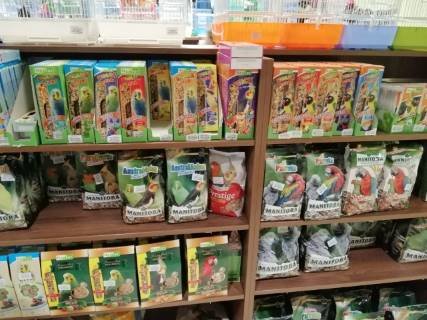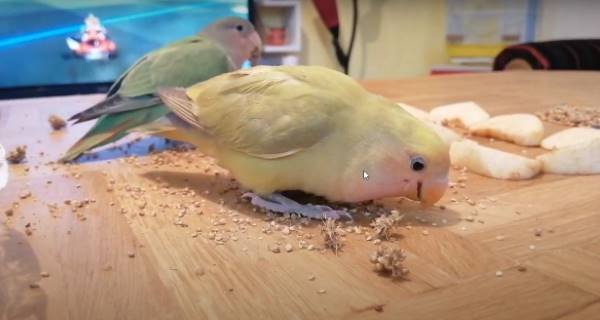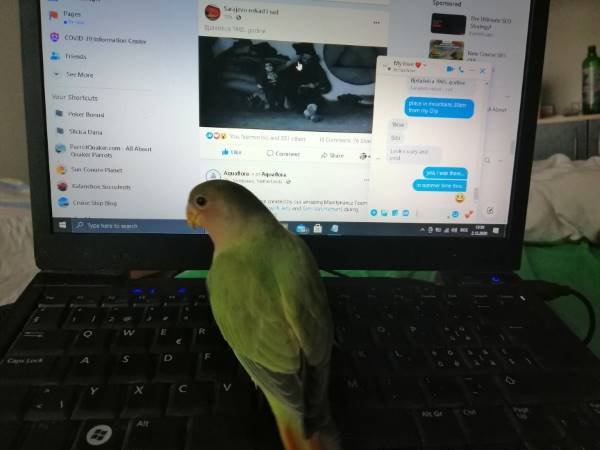Pellets, seeds, fruits, vegetables, beans, legumes. There is so much to offer, that one might get confused on what to serve and what to leave out on a typical day. Let’s see what should be served in all cases and how much.
Daily Lovebird Diet
The quality and quantity of the daily feed are imperative in deciding the health of any pet lovebird. And this holds well for all the nine species of lovebirds. Whether it’s Peach-faced, Masked, or Fischer’s Lovebird, they can all be served the following basic routine diet:
Pellets
Pellets are the best-formulated feed that can be served to lovebirds. This is because they are perfectly fortified with all the essential nutrients that a basic diet might be lacking in. They must form around 75-80% of the daily diet.
Are pellets necessary for pet birds?
It isn’t that a lovebird wouldn’t live long if not served with pellets daily. If the owner can manage to add all the essential nutrients and minerals daily to the bird’s feed, he’ll certainly be healthy and thus, live longer. Pellets rule out the chance of any deficiency arising out of lack of awareness on the part of the owner, about ‘what’ and ‘how much’ should be served to the bird every time.
Additionally, it is great for the picky eaters as the bird wouldn’t get the option to pick and choose. This brings down the chances of malnutrition to the lowest. Every pellet is equally fortified just like our breakfast cereals.
Seeds
Just like in the wild, seeds happen to be the default favorite of lovebirds in captivity too. And when it comes to seeds, the menu list can be so long that the bird might not feel bored of the same platter.
Many owners prefer to serve a single seed type at a time to discourage pick-and-choose eating habits. And then others like to offer a seed mix that might contain a few varied seeds. It all depends on the bird’s choice and eating habits.

That said, do not overdo on seed platter as the bird might get malnutrition, sick, or obese. These must be served less than 5% daily or best, on alternate days.
Fruits
Lovebirds can be served all kinds of fruits like apples, bananas, mangoes, cantaloupes, pomegranates, berries, papayas, kiwis, plums, et al. Serve these diced, pureed, or sliced. Always remove the seeds of the fruits before serving to keep the bird from accidentally choking on them. Fruits high in sugar content like grapes or pineapples must be served sparingly.

That said, one might find it difficult to get his lovebird to start eating fruits in the beginning. The key is to make something that is appealing in color and texture as lovebirds fall for these two when it comes to eating. Try a chia pudding recipe with soaked chia seeds served in almond milk topped with fresh fruits and chopped nuts. Lovebirds are known to get enticed by such food platters.
Vegetables
All kinds of vegetables can be served to lovebirds to make their platter wholesome. The dark-skinned vegetables like pumpkin, carrot, or winter squash are packed with vitamin A; the greens like broccoli, spinach, peas, and bean greens are loaded with calcium, fiber, and proteins. Other healthy greens are bok-choy, cauliflower leaves, cabbage leaves, and dandelion leaves.
Do not offer them greens like watercress or iceberg/head lettuce as they hardly have any nutritional value and all water. This will make the bird feel full without them having absorbed any nutrients.
Freshwater
One might not consider it important enough to be mentioned here. But insufficient water intake often messes up a lovebird’s health. Just like humans, water helps in keeping the bird hydrated, optimizing his body temperature, easy digestion, and transporting nutrients across the body, to name a few. And for the hotter days of the year, do not forget to double up the supply 24 hours a day. Lovebird owners in hotter regions end up losing their bird to dehydration, just because they do not deliberate on this consciously.
Treats
There are many treats for lovebirds that are toasted to be their favorite. Apart from seeds, they love to gorge on nuts like almonds, walnuts, cashews, hazelnuts, peanuts, pistachios, et al. But offer them just a quarter of them all occasionally as they are fattening. Anything fresh and hydrating like succulent fruits are also loved by these little parrots.
Also, many lovebirds love pasta. Serve parboiled penne pasta filled with nut butter inside, and watch the little lovebirds’ happy and content face.
Lovebird’s Favorite Food
Lovebirds are known to have an extreme love for millet seeds and can never say no to it. So much so that the seeds are touted as the main icebreaker between a lovebird and its owner by making an easy way to bond.

Then there are sunflower seeds but they are only second best. Though almost impossible, if your lovebird happens not to like millets much, it is best to sunflower seeds to make the bird content.
Supplements for Lovebirds
It is not necessary to serve supplements to all pet lovebirds. Only the ones who are on seed-only diets need supplementation for covering up the deficiencies of minerals and vitamins. Though, an all-seed diet is not a great choice as it can cause many health complications like obesity in the birds.
Lovebirds that are fed around 75-80% pelleted diet should not be given any supplements as the market-bought pellet formulations are already fortified with all the essential nutrients required by lovebirds.
Breeding lovebirds might need supplementation even after being on an ideal pellet diet. This is because they need extra nutrients like calcium and proteins for egg-laying. Each case is specific in this aspect and supplementation must be done only after consulting the vet.
Grit or Gravel for Lovebird
This one is a kind of controversial topic with Lovebird keepers. There is a chance that bird eats too much, especially inside a cage where doses are probably not perfect for its needs.
There are few sources that might help you with a decision:
https://www.parrots.org/ask-an-expert/feeding-grit-to-parrots
https://the-oasis.org/the-dangers-of-grit-in-a-parrots-diet/
I personally do not add Grit to my Lovebirds diet, and they show no signs of digestion problems.
When in the wild, the lovebirds would often eat small soft stones made from grit or gravel. It has silicates that help in wearing off the hard, fibrous coating of seeds inside the bird’s stomach, thereby, making it easier for them to digest the seeds. It also adds calcium to the lovebird’s nutrient profile which is specifically helpful during breeding.
Tips while feeding and buying gravel for pet birds:
- Look for the formulations that do not have charcoal in it as charcoal stops the absorption of certain minerals and vitamins by the bird’s body. Also, if bought from a reputable company, it would have zero chances of being contaminated with lead that has been termed fatal for birds.
- Do not feed it in excess as gravel can cause obstructions in the intestine. The best quantity as suggested by vets is only ⅛ to ½ teaspoon every 2 years. This is because the grit is insoluble and stays inside the bird’s system for years to perform its function.
- And lastly, and most importantly, lovebirds whose seeds are husked, soaked, or sprouted already and are served pelleted diets wouldn’t need gravel/grit for digestion.
Foods Bad for Lovebirds
Not every edible thing is meant to be eaten. Maybe humans can still bear the harm caused by toxic or bad foods, but when it comes to sensitive systems like that of lovebirds, many foods could prove harmful or sometimes, even fatal. Some of such routine foods are:
- Pitted fruits like avocado;
- Caffeinated foods like coffee, chocolate, coke; and
- Alcoholic beverages or food items;
The above three food categories are in the ‘Prohibited Food List for Lovebirds’ category as these can almost instantly kill the little bird even if served in the smallest quantity possible.
The following are the ‘Foods that can make Love Birds Sick’ kind-of category. One must avoid them if he doesn’t want his little bird to fall sick.
- Foods high in acidic content like rhubarb, onion;
- Foods that are greasy or deep-fried like french fries;
- Foods that are high in sugar like candies; and
- Foods that are high in sodium or other spices.
Summing Up
Lovebirds can be fussy eaters if they aren’t made to eat a little of all, early on. Hence, it is best to take special care of their food habits. Do not serve them millets too much as they might boss around to have it all the time. And if they do, serve them a colorful platter to help them move over it. Cooked beans of all kinds are also known to be a lovebird’s preferred food. They also have an edge over seeds as beans happen to be loaded with proteins and fiber. Another healthy swap for fattening seeds and zero nutritional-value fruits and veggies.




